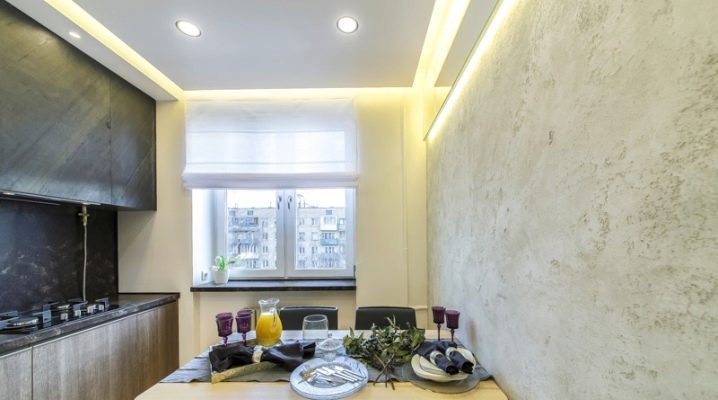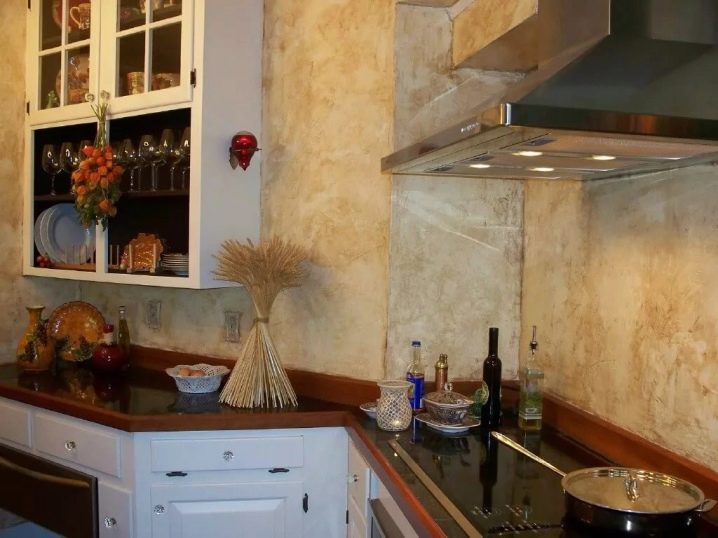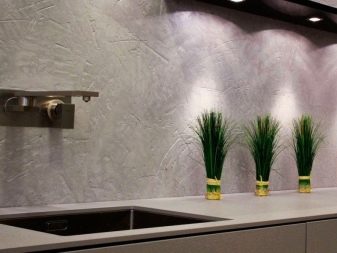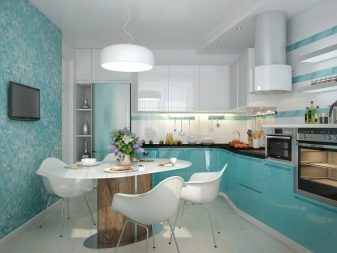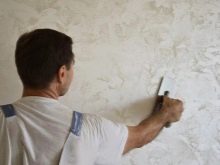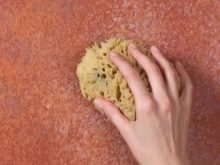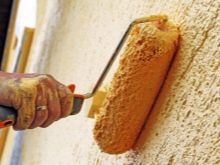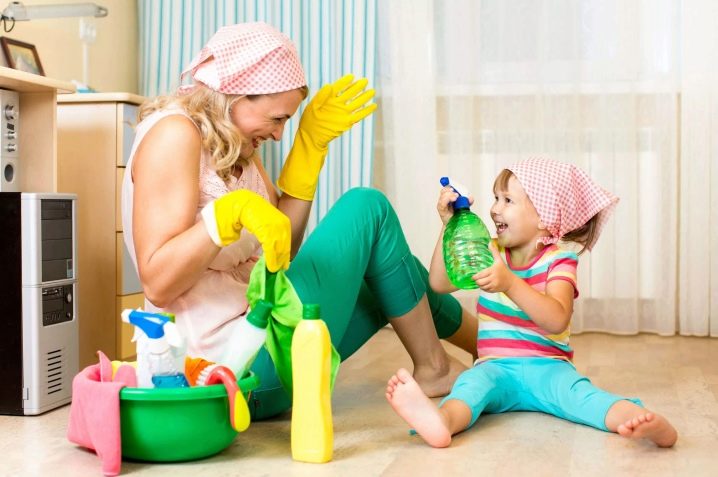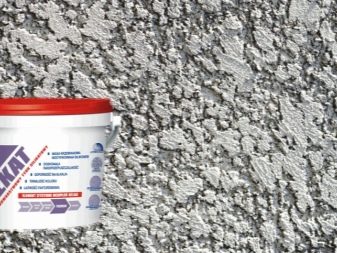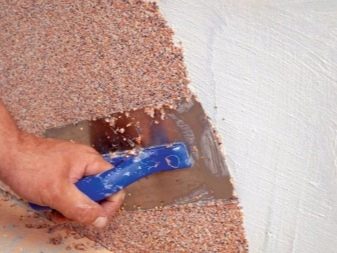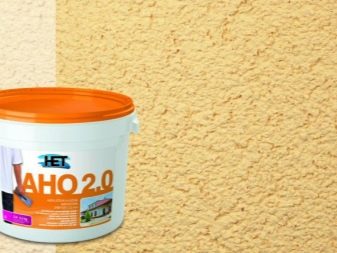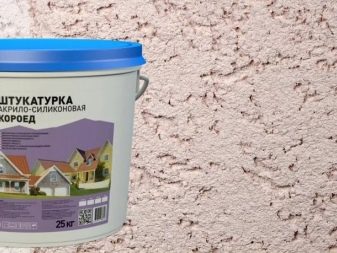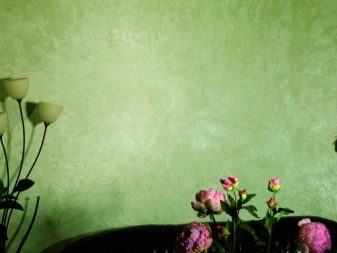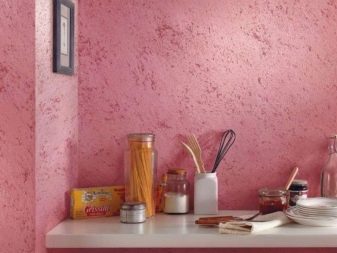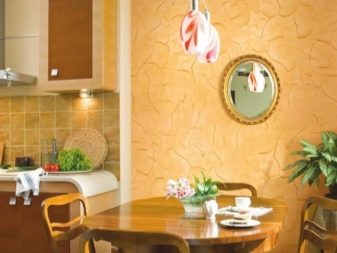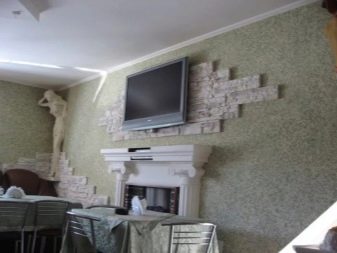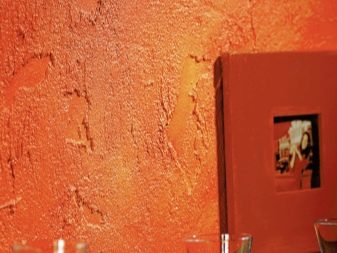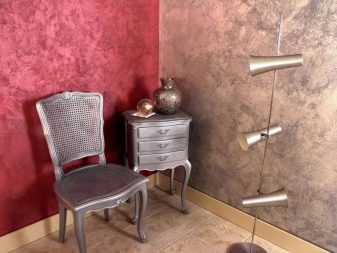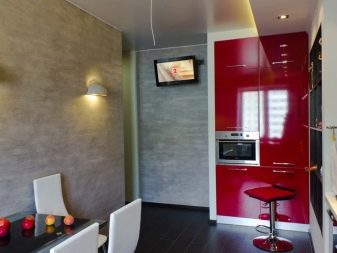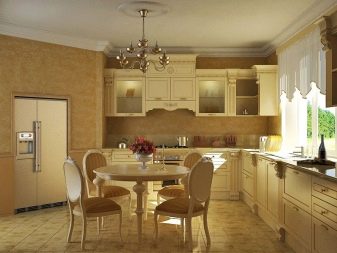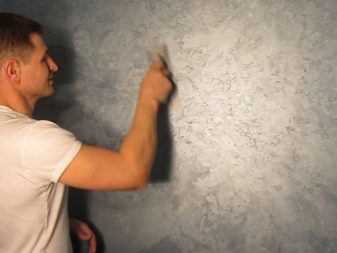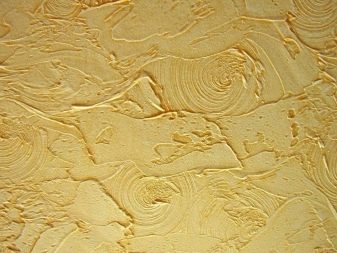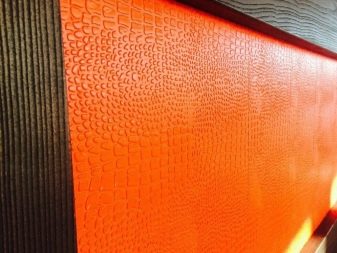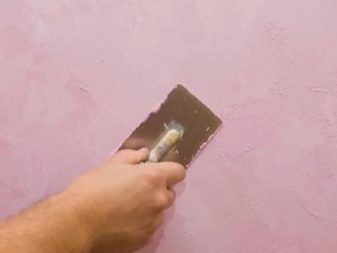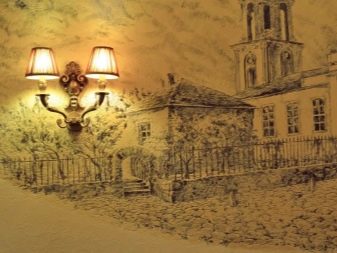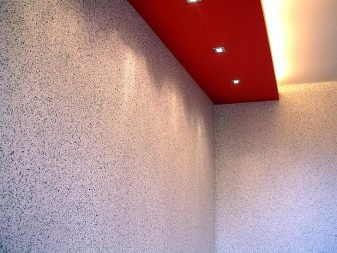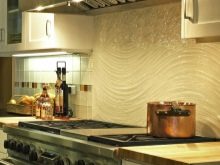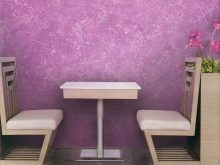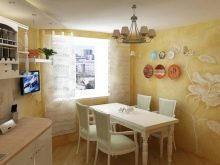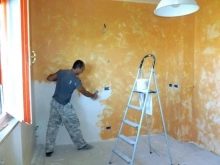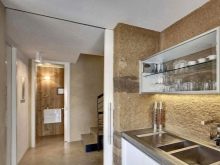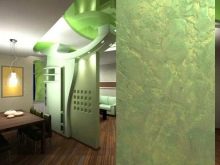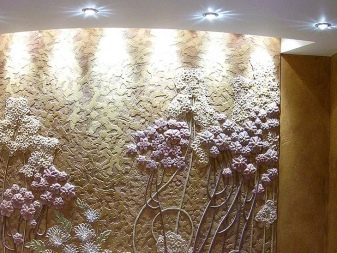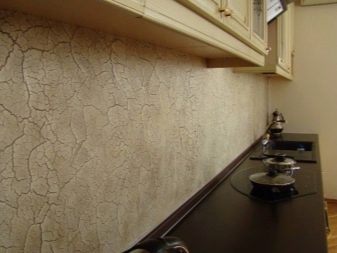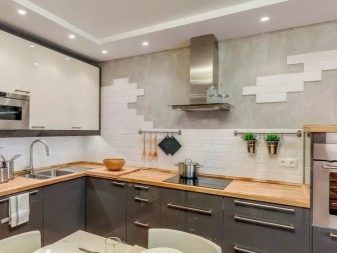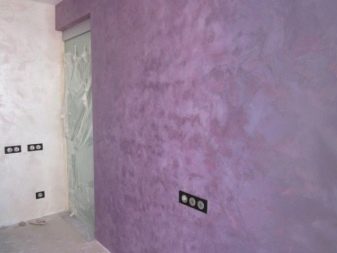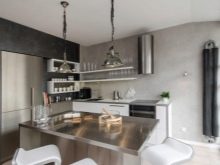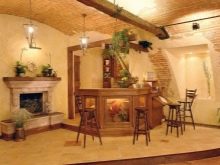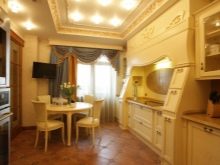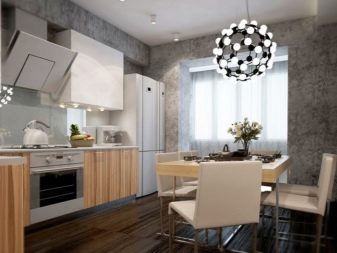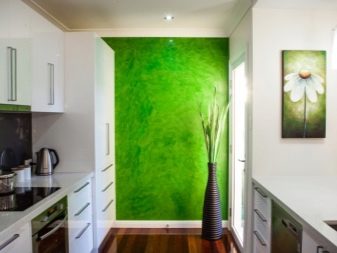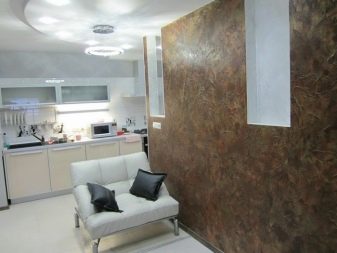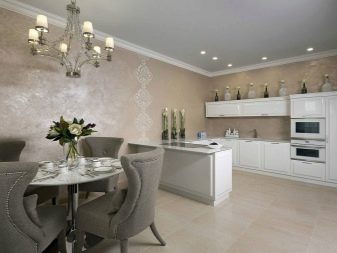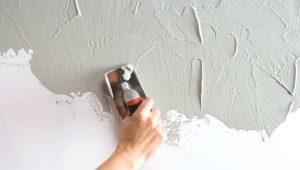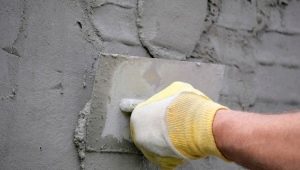Decorative plaster in the kitchen: types and examples in the interior
Manufacturers of building and finishing materials have long adopted the fact that ordinary products for rough work can be adapted for finishing the premises, adding certain properties to them: both decorative and technical. Thus, decorative plaster appeared. What kind of composition and what are its advantages over other finishing materials will be described below.
Special features
When the word "plaster" first of all it comes to mind thoughts about the viscous composition of incomprehensible dirty gray color, which align the walls before applying a finishing coating. But the decorative composition has little to do with the building mixture. is he is a paste with a homogeneous consistency, containing particles of marble, granite, quartz and other components that improve certain characteristics of the coating.
The appearance and final properties of the finishing decoration with decorative plaster will depend primarily on its composition and size of the fractions. From large particles, you do not get a smooth, smooth surface, and various synthetic additives affect the resistance to moisture and various household stimuli.
The second factor that influences the design will be the plaster application technique and the tools used. Instead of standard construction rollers and spatulas, a variety of tools can be used., sometimes completely unexpected (for example, sea sponge). With their help, a variety of patterns and relief patterns are formed.
The kitchen is one of the most attractive places for decoration with decorative plaster. This is a room in which the family, and the mistress of the house in particular, spend a significant amount of time. Therefore, the room should be decorated beautifully, modernly, leave a feeling of peace, comfort and comfort for everyone living in the house.
There are a number of factors that must be considered when choosing the finish of kitchen surfaces.so that they will not lose their appearance and initial qualities for a long time:
- the material used must withstand elevated temperatures and their sharp fluctuations, as well as to be resistant to interaction with organic media;
- strength, moisture resistance and durability will help to survive numerous cleaning and cleaning with brushes, rags and household chemicals, sometimes quite aggressive.
In this regard, decorative plaster for the kitchen - the perfect option.
Kinds
There are several types of decorative plaster. Most suitable for outdoor decoration, and for the interior.
- Mineral plaster. This type of finish consists of natural materials. The base of cement or plaster is supplemented with particles of granite, marble or quartz sand: they give a variety of decorative effects. Cement types of compositions are often used for exterior decoration. Gypsum plaster for the design of the kitchen is not the best option: gypsum does not tolerate high humidity, begins to saturate with water vapor, deform and swell - this type of finish will be short-lived and impractical.
- Silicate plaster can also be attributed to mineral, since the main component of them is liquid glass. This composition gives a huge advantage - allows the walls to breathe.Therefore, silicate mixtures can be applied without fear on wooden substrates or porous concrete walls.
- Acrylic blends - ideal for finishing kitchens. Acrylic gives the coating strength, beautiful shine, long service life and low abrasion. This finish is easy to clean and maintain in its original form, and the mass of colors allows you to choose a tone for the soul.
- Silicone coating easy to work with. Increased plasticity allows it to be applied to the walls even to an unprepared master. Excellent adhesion characteristics allow the use of silicone plaster for virtually any type of primary surface.
Color solutions
Modern technologies allow to get any color palette. In the kitchen you need to build on the functionality of the room, the necessary mood and, of course, the style.
- Plasters that mimic natural surfaces will look better in shades close to natural stone: pinkish, beige-brown, gray, greenish.
- For the decoration of the kitchen it is better to dwell on a warm range of colors: it will give comfort and coziness, rekindle your appetite.
- Bright colors, such as red, malachite, wine, will look spectacular in the decoration of Venetian technique. Of course, it is better to design only one wall in this way, because an abundance of saturated color will irritate the eyes, bring in a tense and even aggressive mood.
- If you choose a kitchen suite with an active color or with a glossy texture, it is better to decorate the walls in a calm pastel range, choose structures with a small relief and an unexpressed pattern. Then the harmony in the decoration will be respected.
- Milk-beige colors are suitable for classic interiors. They can also finish the ceiling. This reception will give a highlight to your dining room.
Texture
A variety of textures is the main feature of decorative plaster. From the same material, you can create completely different types of surfaces with different decorative effects.
- Venetian technology suggests a wide variety of options. Features of application allow you to simulate the natural gloss and gloss coating. The popularity of Venetian plaster does not fade away and is used in large quantities.interior styles. The marble crumb in the composition allows to obtain a seamless coating that imitates natural marble. With the help of various additives get pictures with sparkles, various layers and divorces. Shades can be both pastel, and saturated, bright and dark.
- Structural coating it turns out due to use of granules up to 3 mm in size. In the process of finishing the walls, these particles create unique and original drawings. Large granules can form noticeable deep grooves. The result is a fairly common pattern of "bark beetle". The “fur coat” and “lamb” types can also be obtained by this method. Fashionable decoration is now imitation of the walls "antique". Such a coating can be achieved by using the composition with the effect of "craquelure". After it dries, the wall is covered with cracks, forming an arbitrary, but interesting pattern.
- Textured group of plasters involves the imitation of various materials. This could be wood, concrete, the walls of the mud hut, the skin of various animals (for example, snakes or python), crumpled paper, and so on. This is an excellent way to decorate your kitchen in any style, while minimizing costs.Still, valuable breeds of trees or genuine leather of reptiles, although applicable for decoration in the interior, but the price of this material is sometimes simply transcendental. And, of course, it is much harder to care for natural surfaces: they will quickly lose their presentable appearance in the kitchen under the influence of fat, moisture and temperatures.
- Smooth coatings suitable for budgetary options, and for an extraordinary designer interior. Typically, the compositions are applied in two or more layers. If you have bright furniture and accessories or unusual textiles on the windows and the desk, why not balance the walls with a simple and calm finish that is easy to apply and maintain.
- Sgraffito. This is a form that allows the use of various stencils to create extraordinary drawings that create an additional emphasis on the walls.
- Flock - this is a relatively new design technique with decorative plaster. Textile fibers are applied to the treated surfaces to form a new structure. The basis turns out similar to silk fabric. This is a very spectacular and noble type of decoration, but it is better to use it only in large kitchens for finishing dining areas, because the abundance of pollutants and the complexity of care will quickly lead to the loss of a chic look and original beauty.
Pros and cons of use
Decorative plaster has a number of advantages when used in the interior.
- Reviews of numerous consumers who have already taken advantage of this type of decoration, say that a uniform covering of the walls or ceiling is very important. In the kitchen, this plus is especially relevant: fat and dirt over time gets into the tile joints, the grout darkens and is difficult to clean. You can not even talk about wallpapers: they are hard enough to glue so that the joints are not visible, and with frequent use and interaction with mechanical stimuli, the edges of the sheets can start to move away. All this makes it look sloppy, messy and untidy. Seamless plastered surface gives the integrity and completeness of the overall picture.
- Long service life allows you to enjoy a beautiful finish for many years.
- Decorative plasters are resistant to the effects of temperature and their differences, insulate sound and heat, and also do not absorb odors, which is especially important for the kitchen.
- Ease of care. The coating can be washed with any household products using water.
- The surface is safe and environmentally friendly.The material does not fade and is not susceptible to microorganisms.
- Plaster can handle any type of base, which does not limit the scope of its application. Surface preparation is minimal, which saves time and labor.
- Large selection of colors and textures.
- Economic expense of structure.
- In case of damage to the finishing area, it is possible to restore it.
Like any other coating, plaster has its drawbacks:
- To remove the coating is quite difficult. If you decide to change the design of the room, then get ready for a long, complex and dirty work.
- New homes are not suitable for finishing this type of compositions. Plaster does not have elasticity, so shrinkage in new buildings will lead to the formation of defects, chips and cracks.
Designer Tips
- If you prefer traditional types of finishes, then you should make an apron around the working surface of ceramic tiles, and finish the rest of the walls with decorative plaster with a fine relief in soothing colors.
- Bright and unusual decor can be created using Venetian plaster.One of the walls of a bright saturated color will emphasize your individuality and add color and mood to the interior.
- Design using imitation wood or concrete is characteristic of industrial style. The deep gray color that accentuates the rough finish will balance the laconic white kitchen unit.
- If there is a fireplace in your kitchen, then a natural stone finish is an excellent choice for its decor. The noble interior is suitable for both the apartment and the country house.
- Classic patterned furniture, vintage lamps, an abundance of gilding in fittings and a crystal chandelier will perfectly complement the plastered walls with golden tints.
Beautiful examples for inspiration.
- Do not be afraid to use active colors in the interior. Juicy green accent on one of the walls will add positive and summer freshness to the kitchen design.
- Industrial style perfectly fits concrete walls into the overall picture. A little warmth and comfort can be added with the help of decorating a kitchen set and floor "under the tree".
- For the design of a studio apartment, it is necessary to thoroughly think over the repair, because the wall covering in the kitchen-living room will be subject to additional negative factors. In this case, you need to zone places for rest and absorption of food.Venetian plaster saturated dark shade, something resembling leather, perfectly cope with this task.
- There is one more example of successful zoning with the help of plaster: a laconic white kitchen can be separated from a more classic tender dining room with the help of a pattern on the wall of large air ornaments.
Read more about the "Venetian" plaster in the kitchen, see below.
